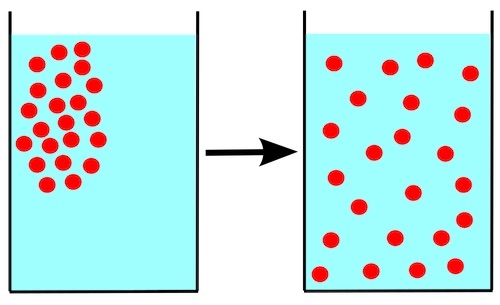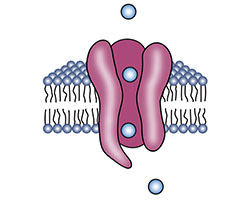show/hide words to know
ATP: adenosine triphosphate. ATP is the energy-carrying molecule of all cells......more
Gradient: a slow or gradual change from one thing to another; a slope or hill.
Ion: an atom or molecule that does not have the same number of electrons as it has protons. This gives the atom or molecule a negative or positive charge... more
Protein: a type of molecule found in the cells of living things, made up of special building blocks called amino acids.
Concentration Gradients
Our bodies need energy for just about everything they do. We use energy to think and to breathe. We also use energy to move things within our bodies, whether we are moving large muscles or tiny nutrients. All organisms spend energy to build molecules. One of the ways this is done is by using energy created by concentration gradients.
Concentration can be thought of as how common something is in a specific area. Imagine sticking a Popsicle into a glass of water. The Popsicle has sugar and flavoring all packed in tight, but as it melts, that sugar and flavoring starts to mix with the water.
Why doesn't the melting Popsicle stay separate from the water? Because molecules tend to move from areas of high concentration to low concentration. There is no sugar in the water, so sugar moves away from the Popsicle and mixes into the water. Movement like this is called diffusion. Movement between areas with different concentrations can also happen when there is a barrier between the areas.
Inside of organisms, these barriers are often membranes. Membranes are sheets of material that act as boundaries. As an example, membranes surround cells. Sometimes within these cell membranes, special passageways exist that still allow molecules to move in and out of the cell. We call these channels or transporters. Many channels and transporters control what materials they allow to go in and out of the cell. Because of this, differences in concentration of materials can occur between the space inside or outside of the cell.
Moving On Down (the Gradient)
When the concentration of something builds up on only one side of a membrane, we call this a concentration gradient. Concentration is high on one side, but low on the other. Let's think of this in terms of a hydrogen ion, H+. Hydrogen ions naturally move down this concentration gradient, from high to low concentration.
Think of the ions as trying to even out the concentration of the areas. To understand this idea, imagine that ions are water and the cell membrane is a dam. If one side has a lot more water, lots of pressure is on the dam.
When the flood gates open, water will flow through (from the side with lots of water to the side with less water) until the water on both sides of the dam is level. As the water flows through the dam, it can be used to turn a turbine (like a water wheel) to generate electricity.
When we look back to cell membranes again, movement "down" the gradient can be used to help store more energy from the gradient in molecules like ATP. As an ion passes through the membrane, it usually goes through a channel or transporter made by a protein. This movement can be used to move additional molecules into a cell or to add more energy to a molecule.
Additional images via Wikimedia Commons. Diffusion image by JrPol.
View Citation
Bibliographic details:
- Article: Concentration Gradients
- Author(s): Joshua Haussler, Karla Moeller
- Publisher: Arizona State University School of Life Sciences Ask A Biologist
- Site name: ASU - Ask A Biologist
- Date published: December 19, 2015
- Date accessed: April 17, 2024
- Link: https://askabiologist.asu.edu/concentration-gradients
APA Style
Joshua Haussler, Karla Moeller. (2015, December 19). Concentration Gradients. ASU - Ask A Biologist. Retrieved April 17, 2024 from https://askabiologist.asu.edu/concentration-gradients
Chicago Manual of Style
Joshua Haussler, Karla Moeller. "Concentration Gradients". ASU - Ask A Biologist. 19 December, 2015. https://askabiologist.asu.edu/concentration-gradients
Joshua Haussler, Karla Moeller. "Concentration Gradients". ASU - Ask A Biologist. 19 Dec 2015. ASU - Ask A Biologist, Web. 17 Apr 2024. https://askabiologist.asu.edu/concentration-gradients
MLA 2017 Style

Molecules tend to spread out to have more uniform distribution, rather than staying concentrated in one area.
Be Part of
Ask A Biologist
By volunteering, or simply sending us feedback on the site. Scientists, teachers, writers, illustrators, and translators are all important to the program. If you are interested in helping with the website we have a Volunteers page to get the process started.









